Mona Hodgson's Blog, page 21
August 7, 2013
Guest Author: Lori Benton and Book Giveaway
The day I’ve been waiting for . . . Lori Benton is our guest!
Author Lori Benton
Lori is a debut novelist whose work reads like that of a polished veteran storyteller.
Lori writes historical fiction set on the American Frontier.
Lori’s storytelling brings to life the Colonial and early Federal periods of American history.
Lori’s milestone 30th birthday gave her a chilling and thrilling God-story to share.
And how about this 4 1/2 Star review from Romantic Times: “…a haunting, moving and masterful story that … will linger in your heart for years to come.” RT Book Reviews Pick of the Month
MONA: Welcome, Lori! I’m delighted you’re with us today. And so excited to let my readers know more about your breathtaking and heart-stirring debut novel, Burning Sky!
LORI: It’s my pleasure to visit. Thank you for giving me the opportunity to talk about history, writing, and faith–three of my favorite subjects.
MONA: What Bible verse is most meaningful to you right now?
LORI: I don’t have to pause to think about it. Philippians 4:13 I can do all things through Christ who strengthens me.
This past year continues to be quite the challenge. I’ve gone through my first novel’s editing, the beginnings of promotion and marketing, and very soon now its release (and the simultaneous editing of my second novel), preparing two proposals for my agent, all while endeavoring to research, plot, and write a new novel, something that used to be my sole (and soul) focus.
I’ve been writing long enough to have met many published writers, so I knew how demanding a published writer’s life would be. But knowing and experiencing are different animals. I’m enjoying so much about what I’ve found on this side of the publishing door, but it is a lot of hard work. There are many necessary (often very interesting) things to do that are all about the writing, but aren’t writing, which of course is what my heart is longing to do all the time.
I’m learning to take it one day at a time, to trust God for today (and the things on my plate today), for peace, patience, and the dedication to use my time as wisely as I can. And to cease worrying about or setting my sights on tomorrow (a great way to trip over today).
A Stellar Debut Novel by Lori Benton
MONA: The New York frontier serves as the setting for Willa’s story, set in 1784. What drew you to this setting and time period?
LORI: A combination of things drew me. My own fiction reading, for one. I’d read two general market series set at least partly in New York during the 18th century, one by Diana Gabaldon, the other by Sara Donati. So I knew Very Interesting Things had happened in New York during the late 18C.
The first 18C novel I wrote was set in North Carolina, but the types of themes I was drawn to—the experiences of men and women caught in the Middle Ground between cultures and races—had already emerged. It didn’t escape my notice that New York’s history, particularly during the Revolutionary War era, is rife with stories of such men and women, European, African, and Iroquois. By the time I finished spilling out that novel set in North Carolina, I had several kernels of the story that would become Burning Sky sprouting through the soil of my imagination. It turned out to be an abundant harvest, and I hope to write more stories about the history of New York during the 18th century.
MONA: I had the privilege of reading Burning Sky ahead of its publication. What sparked the idea for Neil MacGregor’s story?
LORI: The character of Neil MacGregor has had a long and interesting journey. I first wrote him into a contemporary story set on the Oregon coast—his character was initially inspired by the movie Man Without A Face. Neil’s physical disabilities and challenges (and his heart’s desire, in spite of them) were largely the same as they are now, but how he dealt with them in that original story was very different than what readers will find in the pages of Burning Sky. In fact, he dealt with them much more like Willa Obenchain, the heroine of Burning Sky, attempts to deal with her struggles, through isolation and retreat from the world.
Halfway through writing that contemporary story, I faced my own battle with debilitating illness. I was diagnosed with Hodgkin’s Lymphoma in 1999, and while I responded well to the treatment and was in remission within months, I wasn’t prepared for one long-term side effect: chemo fog. When I returned to writing, I discovered I could no longer focus, or remember what I’d written a week or even days ago. Nothing I researched would stick with me. My memory was shot full of holes. It was a frustrating and disheartening season. It was also a season of deepening, and refining.
It would be nearly five years before I was healed enough to write again the type of books I longed to write. Burning Sky was the second novel I finished after that season of fog, and happily Neil MacGregor made the successful time-travel and found his story-home there. Because of the challenges I went through with chemo fog, and my path to recovery, I found the character had grown as well—grown in faith and maturity, grown in hope and trust. He’s a different Neil MacGregor, in spite of the similarity his experiences bear to that early incarnation. But he’s a truer Neil MacGregor.
MONA: We really appreciate your vulnerability, Lori. Thanks for sharing bits of your own story with us. What were the intersection points at which Willa’s journey crisscrossed with your personal journey?
LORI: Willa is easily the heroine least like me that I’ve ever written. While I identify more strongly with Neil’s journey, all that he is striving to overcome, there are certain aspects of Willa’s character journey that I recognize in myself. Foremost among them is Willa’s tendency to isolate herself rather than risk all that comes with forging deep personal relationships. There will always be two sides to that coin. Joy and blessing on one side, pain and loss on the other. We live in a fallen world. But we are meant to live here, not merely exist, until God calls us home. I believe He wants to (and can and does) use even the painful realities of living in a fallen world—like loss and separation—for our good.
MONA: What valuable insight. Thanks, Lori. What is one (or more) of the most interesting things you learned while doing the research for Burning Sky?
LORI: One of the most interesting things I learned while researching the history of the New York frontier is woven only briefly into the pages of Burning Sky, and that is the experience of the Six Nations of the Iroquois Confederacy during the 1770s and 1780s. Their journey through this tumultuous time is one of the most painful and difficult subjects I’ve researched, and one of the most compelling and inspiring.
The Revolutionary War saw a breaking of the centuries old Iroquois League, as the Mohawk, Onondaga, Cayuga, and Seneca nations allied with the British, while the Oneidas and part of the Tuscarora nation allied with the patriots. These were terribly hard and often bewildering decisions for each nation to make. They were choices years in the making, with many attempts to remain neutral and at peace. But pressure to align proved too great, and ultimately it became a civil war for the Iroquois, one in which there was no winning side. They lost so much, even our allies, and I don’t know that that’s remembered as it deserves to be. There are many incredible stories of Iroquois men and women who sacrificed, fought, and served to see our country birthed. I hope one day to tell some of them.
MONA: You have a second book scheduled for release with WaterBrook Press, can you give us a hint, or two? Is the story a sequel to Burning Sky? Same setting? Some of the same characters?
LORI: The Pursuit of Tamsen Littlejohn will release in spring of 2014. It’s a stand-alone novel with a different set of characters, and a different setting—western North Carolina (present day Tennessee), 1787-88. This was a unique and tumultuous time period across the Blue Ridge Mountains that I believe will surprise many readers. The story bears similarities to Burning Sky in that it explores those themes of identity, loss, and the pull between life-paths, races, and cultures, but these themes are explored through the hearts and minds of a frontiersman, Jesse Bird, and a cloth merchant’s daughter, Tamsen Littlejohn.
MONA: Some writers thrive on writing the first draft while others most enjoy digging into the revisions. What’s your favorite part about writing a book?
LORI: I enjoy both for different reasons. Writing a first draft is hard, hard work, and fraught with insecurities, unknowns, anxieties—and that’s after I’ve plotted and researched to a fare-thee-well. Those things are for the course, and I’m able to not take them too seriously. But there’s nothing quite as satisfying than staggering away from the keyboard, thoroughly spent and exhausted, after getting down a scene or a chapter, or whatever portion of the story I sat down to write. Of a scene existing where before there were only notes, or a few scraps of dialogue and description.
Once that first draft is done comes a tremendous sigh of relief. The sense of a burden lifted. Then the real fun begins. There’s something about having that first draft—scene, chapter, or the whole book—finished that enables me to peel back layer after layer and go deeper with the various story elements, to play with language, deepen theme, really capture a character’s voice, and be surprised by unexpected nuance. To polish and reshape and polish again, until the whole better resembles that first flash of inspiration, when I saw the story spiral out in its fullness. Those flashes can never be tamed, or even fully captured. Writing, for me, is the process of recalling that fleeting glimpse I had of the whole—like watching a film on fast forward, then trying to recreate it one word at a time.
MONA: What advice do you have for those who dream of being a published novelist?
LORI: Read. Read all the time. Read all kinds of books, but especially the kind of books you want to write. And write. Write as much as you can. Write the kind of books you want to read. I was once told by a successful writer that if you do those two things, and don’t stop, you will improve. Be patient. It takes time.
One more thing I’ve learned by experience: love the writing first, best, and always. Even as you pursue publication, do whatever it takes to get to the place where the writing is joy enough. You will need that joy to sustain you after you’re contracted, especially if you’re an introvert like most of us writers tend to be.
MONA: Lori, we appreciate your taking the time to sit with us a spell, sharing from your heart, and offering a giveaway copy of Burning Sky. Thank you!
LORI: It’s been my pleasure, Mona. Thanks for giving me a chance to share on some topics important to me.
Willa is a woman caught between two worlds!
Read an Excerpt from Burning Sky.
What did you learn about Lori or her writing that intrigued you most?
COMMENT ON THIS POST TO ENTER THE FRIDAY 8/9/2013 MIDNIGHT DRAWING FOR A COPY OF BURNING SKY. USA addresses only, please. Your comment must include your email address!


August 6, 2013
Prairie Song – In Search of a Promised Land
PRAIRIE SONG launches today! Thank you for celebrating with me. What would drive people from the familiar into the unknown? What would cause men to venture into a harsh wilderness, leaving their families behind? Or uprooting them? For the Israelites, it was captivity in Egypt and the hope of freedom in a Promised Land that […]
The post Prairie Song – In Search of a Promised Land appeared first on Mona Hodgson.
August 2, 2013
Summer Salad Recipe – Spaghetti Chicken
Temperatures start rising. The oven takes a vacation and salads take center stage at the Hodgson house. Here’s one of our family favorites–a spaghetti salad, of sorts. Quick to make. Light and cool to eat on hot summer days. Easy to carry to a potluck or out for a picnic.
S paghetti Chicken
1 package spaghetti noodles, cooked and drained
2 tablespoons olive oil or marinade oil from artichokes
½ cup red onion or sliced green onions
1 ½ cup tomatoes (I like Roma, cherry, or grape), chopped
2 cups marinated artichoke hearts, chopped
2 cups cooked chicken, diced or sliced (leftover from a baked chicken or from a package of mesquite grilled)
Mix all of the ingredients in a serving bowl or layer them on a serving platter. Serve with parmesan cheese and warm garlic breadsticks (or bread of your choice).
Do you have a favorite summer dish or salad? We’d love to see the recipe!
July 31, 2013
Grace in Song X 7
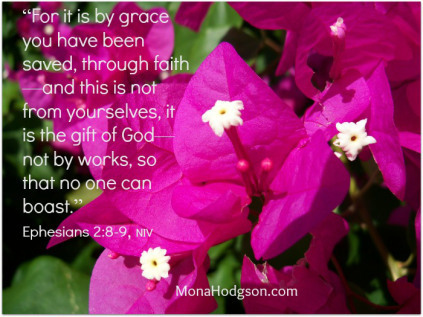
God’s amazing grace and mercy is a favorite theme of mine. Thinking about it, reading about it, and singing about it. Here is a collection of seven of my favorite music videos that feature God’s grace.
Click on the song titles to listen to the song and watch the video.
The Beauty of the Cross by Jonny Diaz
Your Grace is Enough by Chris Tomlin
Amazing Grace My Chains Are Gone by Issac Watts and Chris Tomlin
Grace by Michael W. Smith
by Matthew West
Grace Tells Another Story by Mercy Me
Every Season by Nicole Nordeman
Do you have a favorite song that celebrates God’s grace?


July 29, 2013
Prairie Song Campfire Supper
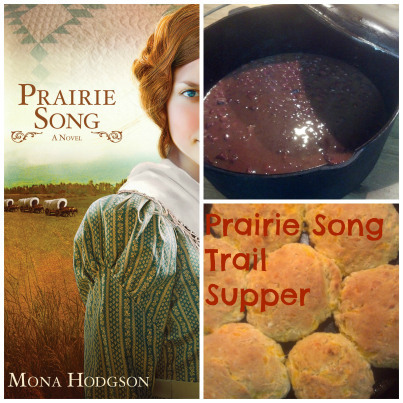
Boney’s Trail Beans and Biscuits
Boney’s turn to cook supper. A fact that has the Boone’s Lick Wagon Train Company captain, Garrett Cowlishaw, and the other four trail hands sticking close to camp. All the wagons are set in their curved line, the livestock graze hobbled in the meadow, and the company’s children haul buckets of water up from the creek. Men are greasing wheels and tending hooves while the women see to their families’ needs.
Outside the company’s chuck wagon, supper boils in an iron pot suspended over the campfire. The scraping of the wooden spoon along the sides of a tin bowl says mealtime won’t be long off now.
Granted, Boney’s Salt Pork and Beans are worth waiting for. Savory and rich. But it’s the wiry fellow’s biscuits his buddy’s mouths water for. Steaming. Golden brown and flaky.
Good news! Since Boney and I go way back and I featured him in the Sinclair Sisters of Cripple Creek Series, I was able to talk him into sharing his recipes.
BONEY’S CAMPFIRE BEANS
2 lbs dry red beans (or substitute with your favorite beans)
12 oz salt pork
Two small white onions, chopped
1/4 cup brown sugar
1/4 cup molasses
2 cloves garlic, crushed, or 1 tsp garlic powder
1 tsp salt
1 tsp coarse ground pepper
In a large pot, place the dried beans and cover with about two inches of water. Bring to a boil for about two minutes, then turn off heat. Let sit overnight. If the beans soaked up all the water, add enough to cover them again.
Remove any skin from the salt pork and cut it into 1/2 inch cubes. You can leave the skins on, but a lot of my men don’t have the chompers to deal with ‘em. Place in a pot and cover with water. Boil until foam forms on top. Drain off water and foam.
Cover with fresh water and bring to a simmer. Cook about 20 minutes, until pork is tender, then drain and add to beans.
Place beans, with water, (it will look like a pot of mud) on a stove or nestle it in the coals at the edge of the campfire.
Add all other ingredients. Stir occasionally, gently so as not to break open the beans.
Cook slowly until the beans are soft or you just can’t wait any longer. About 5 hours.
If you want thicker beans, shake up some flour in a little of the bean water and stir it in. You will have to estimate on this, as I don’t know how much water you boiled off.
There should be enough here to feed the whole crew, unless Tiny shows up.
BONEY’S TRAIL BISCUITS
2 cups all purpose flour
1 teaspoon baking soda
1/4 teaspoon salt
1/4 cup soft butter
1 cup buttermilk (or add 2 tablespoons lemon juice to milk to make 1 cup and let sit for about 15 minutes)
3/4 cup (loose) grated/shaved cheese (we used medium cheddar), if desired
2 tablespoons butter for brushing the biscuit tops, if desired
Preheat oven to 400 degrees. Mix flour, baking soda, and salt in a medium bowl. Cut in butter until the mixture looks crumbly. Quickly stir in the buttermilk until mixture is moist. On a lightly floured surface, knead dough. Dough will be moist but not sticky. Roll or pat to about 1/2 inch thickness. Cut with biscuit cutter or follow Boney’s lead and use the top of a tin cup.
Bake on an ungreased cookie sheet in preheated oven at 400 degrees for about 15 minutes. About 10 to 12 minutes into the baking brush biscuit tops with the extra softened butter.
Boney said he would have baked his biscuits in a Dutch oven at the campfire. My hubby used Boney’s recipe and baked them in an oiled (olive oil spray) cast iron skillet, which takes about five minutes more oven time.
Enjoy!
If you were on the Oregon Trail and cooking supper over a campfire, what would you fix?


July 19, 2013
Wagon Train Overlanders Speak
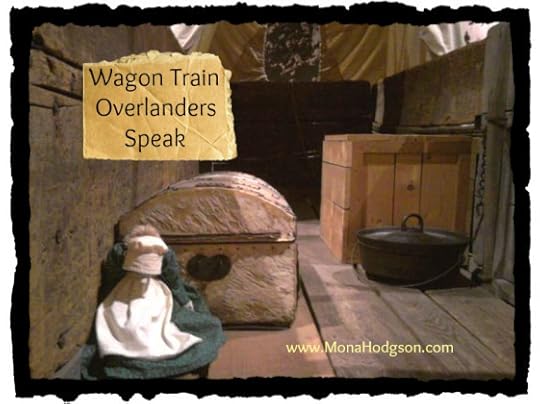
Photo taken at Westward Expansion Museum
St. Louis, Missouri
Since I write women’s historical fiction, it makes sense that I’d want to hear from women and men from the time and period in which I’m setting my stories. For my Hearts Seeking Home Series, I turned to the diaries and journals of folks who had made the trek west by covered wagon. The grammar, spelling, and punctuation remains authentic, as found in the diary entry.
March 14, 1854 We picked out two other quilts with patterns Ann and I especially like: the Memory Block, made with bits of material from relatives’ clothing, and the appliqued Mountain Lily in bright colors. The Slave Chain quilt, stitched by our black mammy, we kept to remind us of the dear woman who took care of us when we were young. Trail of Thread – Historical Letters 1854-1855 by Linda K. Hubalek
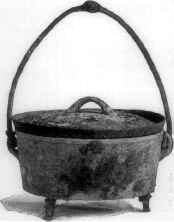
Photo Credit: Wikipedia
March 19, 1854 Soaked dried pumpkin slices for a pie. I had to wait until the chickens laid some eggs before I could stir up the filling. Rolling out the crust was a little frustrating because the wagon end we use for a table is much higher than the table in my kitchen. I couldn’t get the leverage I needed until I stood on my overturned pail. With limited baking utensils along, I have to plan the meal around what I can fit in the skillet, or the kettles. Trail of Thread – Historical Letters 1854-1855 by Linda K. Hubalek
April 27, 1851 This is the second Sabbath of our journey. This morning it was windy and unpleasantly cold, but this afternoon the sun is shining brightly, and thought the wind still blows ugly, it is warm, and everything seems cheerful, rejoining in the goodness of its Creator…. At noon Mr. Kern’s children and ours, including myself, went in the woods and held a Sabbath school. We sang a hymn, read the 27th Psalm, spoke of it, read a tract, sang the doxology: “Praise God from whom all blessings flow” then returned to the camp. It was very pleasant and I trust that good Being of whom we met to converse, looked upon us approvingly. Eugenia Zieber, Covered Wagon Women – Diaries & Letters From the Western Trails, 1851
May 8, 1953 Still in camp waiting to cross. There are three hundred or more wagons in sight and as far as the eye can reach, the bottom is covered, on each side of the river, with cattle and horses…. Every company should have a waterproof wagon for this purpose. Amelia Stewart Knight, Going Along the Emigrant Trail
![oxen_in_yoke[1]](https://i.gr-assets.com/images/S/compressed.photo.goodreads.com/hostedimages/1381271955i/4624583.jpg) May 8, 1851 Crossed the Missouri River. Drove 2 miles and encamped. Our company consisted of 14 wagons with from 4 to 6 yokes of oxen to each and about 30 head of loose cows and young cattle and 14 horses. Susan Amelia Cranston, Covered Wagon Women – Diaries & Letters From the Western Trails, 1851
May 8, 1851 Crossed the Missouri River. Drove 2 miles and encamped. Our company consisted of 14 wagons with from 4 to 6 yokes of oxen to each and about 30 head of loose cows and young cattle and 14 horses. Susan Amelia Cranston, Covered Wagon Women – Diaries & Letters From the Western Trails, 1851
May 23, 1866 Perhaps you would like to know what we have at our meals. We sometimes boil potatoes. We then pick up some codfish and cook it with milk…. We have tea for supper. Ellen “Nellie” Gordon Fletcher, Going Along the Emigrant Trail
May 26, 1851– A violent thunderstorm, with rain from midnight till 8 in the morning; started about noon, the roads very heavy, went 6 miles, when the Captain’s wagon tongue and axle broke, so we are obliged to wait. May 27– All day repairing the Captain’s wagon. May 28– Got 4 miles, when Jones run on a bank and smashed of of his wagon wheels. And awful thunderstorm this evening. Jean Rio Baker, Covered Wagon Women – Diaries & Letters From the Western Trails, 1851
June 3, 1851 Cattle wandered. We consequently did not leave camp till late, fine day & good roads. John spilled over his wagon soon after we started but soon picked up again. Passed several small sheets of water which looked tempting, but Death was lurking there in its limpid waters. Harriet Talcott Buckingham, Covered Wagon Women – Diaries & Letters From the Western Trails, 1851
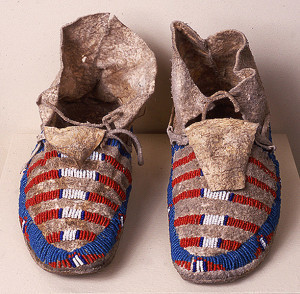
Photo Credit: Nebraska State Historical Society
June 7, 1853 Rained some last night, quite warm today. Just passed Fort Laramie, situated on the opposite side of the river. This afternoon we passed a large village of Sioux Indians. Numbers of them came around our wagons. Some of the women had moccasins and beads, which they wanted to trade for bread. I gave the women and children all the cakes I had baked. Husband traded a big Indian a lot of hard crackers for a pair of moccasins. Amelia Stewart Knight, Going Along the Emigrant Trail
June 10, 1866 There is a large family that had been obliged to lie by on account of an accident which happened to a little child four years old. He fell out of the wagon and the wheels ran over his head and thigh. His head was badly cut and his thigh broken. They had been there several days and the little boy was getting better. He is a sweet little fellow, and reminded me of Rollo. Ellen “Nellie” Gordon Fletcher, Going Along the Emigrant Trail
June 15, 1853 Came 19 miles today; passed Independence Rock this afternoon, and crossed Sweetwater River on a bridge. Paide 3 dollars a wagon and swam the stock across. Amelia Stewart Knight, Going Along the Emigrant Trail
June 19, 1865 We passed two graves this morning that have been made within a month. The first a man who shot himself accidentally three weeks ago. The other a woman, forty years old, who died one month ago to-day. As I stood beside the lonely graves, I thought of the tears that had been shed, the prayers that had been uttered, the desolation of heart that had been endured by those who had been obliged to go on and leave their loved ones here in this wilderness. Sarah Raymond Herndon, Days on the Road – Crossing the Plains in 1865, The Diary of Sarah Raymond Herndon
 July 10, 1866 we are hauled along by four yoke of cattle. “Stars and Stripes” about 3 ft. long, on the bottom of our wagon is heavy machinery filled up with blankets, tobacco for the men–canned fruit–a small keg of whiskey–carpet sacks, mess kit & the blankets making a comfortable loading place. From the Diary of Thomas Alfred Creigh
July 10, 1866 we are hauled along by four yoke of cattle. “Stars and Stripes” about 3 ft. long, on the bottom of our wagon is heavy machinery filled up with blankets, tobacco for the men–canned fruit–a small keg of whiskey–carpet sacks, mess kit & the blankets making a comfortable loading place. From the Diary of Thomas Alfred Creigh
August 1, 1853 Still in camp, have been waiting all day, and all hands have had all the wild currants they would eat, they grown in great abundance along the river: There are three kinds, red, black, and yellow. Amelia Stewart Knight, Going Along the Emigrant Trail
September 6, 1953 Still in camp, washing and overhauling the wagons to make them as light as possible to cross the mountains. Amelia Stewart Knight, Going Along the Emigrant Trail
September 17, 1853 Evening–came 6 miles and have camped in a fence corner by a Mr. Lambert’s, about 7 miles from Milwaukie. Turn our tock out to tolerable good feed. A few days later my eighth child was born. After this we picked up and ferried across the Columbia River, utilizing skiff, canoes, and flatboat to get across, taking three days to complete. Here husband traded two yoke of oxen for a half section of land with one-half acre panted to potatoes and a small log cabin and lean-to with no windows. This is the journey’s end. Amelia Stewart Knight, Going Along the Emigrant Trail

August 6th, Book 1
Hearts Seeking Home Series
Y OUR TURN TO SPEAK UP
Which comment did you find most intriguing or poignant? Is there a particular time period or historical setting you especially like to read about in diaries? Do you have a favorite historical diary?


July 17, 2013
1920s Pharmacies and Soda Fountains

Guest Author: Karen Barnett
While researching the 1920s for Mistaken, I was intrigued by the growing importance of the local pharmacy. When the neighborhood bars closed because of Prohibition, many people turned to the corner drugstore/soda fountain as the new gathering place, trading “hard” liquor for “soft” drinks—at least until the speakeasy opened.
The corner drugstore seemed like the perfect place for my characters to spend time. Four features made 1920s drugstores unique to the era.
Compounding prescriptions: In the 1920s, pharmacists were just beginning to order manufactured medications, but most prescriptions were still prepared by hand. It took careful precision to measure the ingredients and blend them into the proper formulas. Each pharmacy had its own methods, so potency, quality, and dosing varied.

Yunker-Lieman Drug Col
Sedalia, Missouri
Medicinal alcohol: During Prohibition, pharmacists were still allowed to dispense alcohol for medicinal purposes. Prescriptions were written on special government-issued pads, and there were strict rules regarding the amount each patient could be allotted. Even with the regulations, many pharmacists made extra money on the side by doctoring the books and selling additional (ahem) doses.
Show Globes: Show globes were the universal symbol for pharmacies up through the early 20th century. These beautiful glass vessels, either suspended or freestanding, were filled with brilliantly colored liquids mixed from chemicals kept in the shop. Preparing the solutions took practice, and pharmacists often guarded their favorite recipes. There are many tall tales of show globes being used to warn town visitors about quarantines, but most historians believe the luminous colors were simply a way of touting an apothecary’s skills.
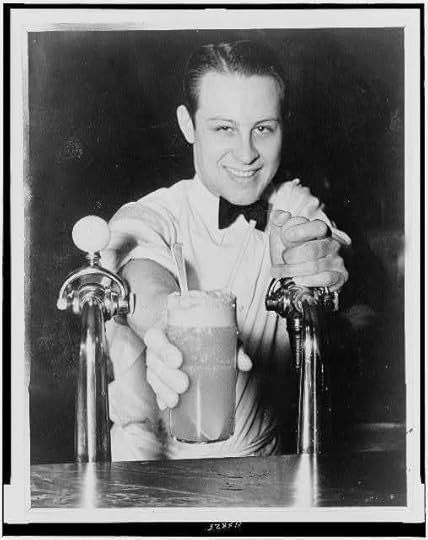
Library of Congress
Photographer Unknown
Soda Fountain: One of the best parts of researching 1920s drugstores for Mistaken involved soda fountains. In order to realistically describe a soda fountain and the various drinks, I needed to do first-hand study. A friend and I made a pilgrimage up to Fairley’s Pharmacy in Portland, Oregon, and spent an afternoon quizzing the soda jerk and tasting various bubbly concoctions. In a few hours, we consumed everything from egg creams (which don’t contain eggs or ice cream!), cherry phosphates, black cows, strawberry ice cream sodas, and green rivers. Oh, research is sweet!
The corner drugstore was a popular feature in towns up through the 1950s. As drug companies streamlined the production of manufactured medications, and soda companies began bottling their fizzy drinks, the need for the drugstore/soda fountain combination faded. A few managed to survive, becoming lunch counters and coffee shops. Today, if you happen into a soda fountain, you’re just as likely to find espressos and lattes on the menu as strawberry sodas and root beer floats. If you find one of those places, take a seat on the cherry-red stool. It might bring back a sweet memory, indeed.
Good news: Karen is giving away a signed copy of her debut novel, MISTAKEN. Comment on this post to enter the drawing, 10:00pm (AZ time), Wednesday, 7/17. Are you a fan of old fashioned sodas? Which variety would you choose–strawberry soda, root beer float, egg cream, or black cow? Be sure to include your email address for notification.
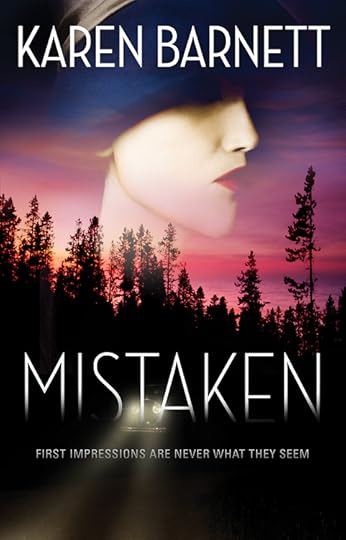
Karen Barnett’s Debut Novel
Watch the book trailer for MISTAKEN! If you love the sights and sounds of the ocean as I do, you’ll want to check out this book trailer.


July 15, 2013
Embracing Grace

Bracelet made by Denise Flynn Forbes, a Reader-Friend
It took me a long while to realize there is so much more to grace than what meets the eye, or the ear.
“The furthest distance I’ve ever known was from my head to my heart.”
Perhaps you’ve heard that line in From My Head to My Heart, the song by Evan and Jaron. I’d heard the song and the statement before, but when it played as part of the soundtrack for the movie, Runaway Bride, the implication hit home. That’s what my spiritual journey had been about–was and is about–my faith in the Sovereign grace of God making its way from a head knowledge to a heart reality. God had blessed me with grace, but I hadn’t even begun to fully unwrap the package.
I was seven years old when I first registered the word grace. At Vacation Bible School at Trinity Baptist Church in Indio, California, Mrs. Bacon referred to God’s grace at the end of the Bible story. She was explaining what sin was and told of our need for God’s amazing grace, extended to us as a free gift because the perfect, sinless Son of God, Jesus’, death for us on a cruel cross. His dying, the punishment for our sins. His glorious resurrection, the root of our hope. The cross, the symbol of God’s grace toward us, undeserved and unearned grace.
That day, June 19th, I put my faith in Jesus, accepting His saving grace–the grace that bridged the gap between my fallible human nature and God’s infallible holiness. Unfortunately, it wasn’t until several years later that I began to grasp a broader scope of God’s grace–its sustaining and transforming power.
As a teenager, I began to realize that salvation was the beginning of my experience with God’s grace, not the destination. But statements like, “What will the neighbors think?” and “Christians don’t do that.” sank deep and told me that my performance–adherence to a list of do’s and don’ts for the sake of appearances–was what mattered most. It wasn’t until my adult years as a wife and mother that I began a true heart-deep experience with the freeing and transforming love and grace of God.
“Clearly no one is justified before God by the law, because the righteous will live by faith. The law is not based on faith; on the contrary, it says, ‘Whoever does these things will live by them.’ Christ redeemed us from the curse of the law by becoming the curse for us.” Galatians 3:11-13, NIV
Rule keeping isn’t a measure of one’s spirituality. Nor is God’s love for me gauged by the success of my pretense or appearance of having it all together. We can’t earn God’s favor. But Jesus gained it for us on the cross. God’s grace relates to our belief, not to our behavior. I could never be “good” enough. Neither can you. Good news! That’s not what it takes to have a loving and grace-full relationship with God.
I write Christian Historical Fiction. What do I write about?
Mining camps, Colorado, life in a river city, Missouri, the Oregon trail and wagon trains. Yes. But those serve as the context for a resounding theme: God’s grace is deep and wide, and oh so sufficient for every thinkable need, and for the unthinkable, too. If you read my historical romance fiction, you’ll read about God’s grace in its many facets. You’ll see it portrayed in various situations and lifestyles. How do we make God’s grace our dwelling place? Not the law. Not pride, which breeds judgment on others. How do we live in the rhythm of God’s grace, not in the lurking shadows of expectations–those belonging to us, and the expectations of those around us? How do we elevate God’s grace instead of giving power to circumstances? Those questions are what fuel my storytelling.
In The Bride Wore Blue, it was Vivian Sinclair. She’d gone against God’s statutes and carried the shame of it like a weight around her neck, sure she was unforgivable. In Dandelions on the Wind, Maren Jensen struggles with difficult circumstances, but see God’s grace in the midst of it. In Prairie Song, Caleb Reger set out on the journey west with a secret. He’d made mistakes that had possibly played a role in ending the lives of others and definitely scarred his own. He struggled with not feeling forgiven.
“For it is by grace you have been saved, through faith—and this is not from yourselves, it is the gift of God—not by works, so that no one can boast.” Ephesians 2:8-9, NIV
According to the Scriptures, performance nor our feelings have anything to do with the reality of God’s grace. Christianity…grace is about Jesus, not about what we can or can’t do for ourselves, or for God. It’s already been done, and He did it!
I write about embracing grace. And what a joy that I get to do so as a storyteller with historical backdrops.
Your Turn
What does grace look like to you? I’d love to hear about your encounter with God’s grace? Or maybe you’re still grappling with grace? You’re not alone. Want to talk about it?


July 5, 2013
A Writer Who Agitates Readers
READER: “Where is the rest of Caroline and Garrett’s story?”
MONA: “Prairie Song! Out August 6th, Penny.”
READER: “That’s almost cruel, you know! :) But crueller still would have been, ‘I decided to end it there.’”
That was an excerpt from a Facebook conversation I had less than two weeks after the release of Ripples Along the Shore, the third and last of The Quilted Heart novellas.
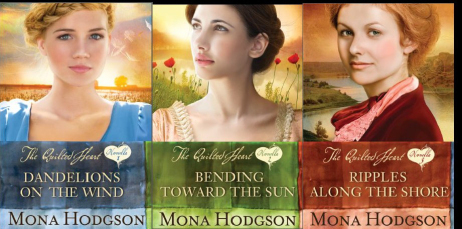
Personally, I think a little agitation is good, don’t you? It tells me I was on the right track…causing my readers to engage with the characters and care what happens next.
Reading the titles of my Sinclair Sisters of Cripple Creek Series–Two Brides Too Many, Too Rich for a Bride, The Bride Wore Blue, and Twice a Bride, you might guess how the stories end. A wedding, perhaps? The mystery is in the complexity of the characters and their relationships, the particulars of their external and internal journeys, the unpredictable nature of the Old West mining camp setting, and in the community interactions.
In The Quilted Heart novellas, I switched things around a bit. Okay, a lot. And in many different ways.
I still gave readers an ensemble cast, a community of characters to follow. And in Bending Toward the Sun and Ripples Along the Shore, I still follow the goings-on of the characters in the first story in the Quilted Heart, Dandelions on the Wind. Those are signature features of my writing style–”community” centered series.
But when writing this series, I left the bows in my literary drawer. Instead of three individual stories, typical of a novella, The Quilted Heart novellas read more like serialized stories such as you would’ve found in Strand or Pearson’s Magazine in the Victorian age. Even though each story had some bits of closure, I started the series with Dandelions on the Wind then kept it going throughout the three novellas and, here’s the kicker, into Prairie Song, Book 1 in the Hearts Seeking Home Series.
I wanted to write stories about a quilting circle. I also wanted to write a wagon train series. Made sense to combine the two, right? So I introduced some of our wagon caravan travelers in the novellas. My second series, The Quilted Heart, serves as a prequel to the third series, Hearts Seeking Home.

August 6th, Book 1
Hearts Seeking Home Series
I experimented with points of view as well. In the Sinclair Sisters of Cripple Creek Series, you’ll read scenes in the points of view of the Sinclair sisters who have already been featured as the main character in the previous books in the series. In The Quilted Heart novellas, you’ll read two or three scenes written from the point of view of the character who will serve as the heroine in the next novella.
Agitating, or enticing? You be the judge.
Here are the links, if you’d like to learn more about these surprising and agitating reads . . .
YOUR TURN
How do you feel about novellas?
Do you like stories wrapped up with a bow, or do you like twists and surprises…loose ends, at least until the next book?


July 3, 2013
19th Century Mercantiles
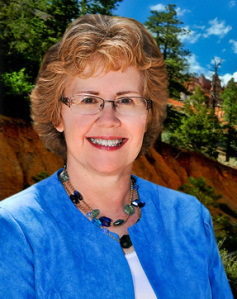
Guest Author: Carol Cox
19TH CENTURY MERCANTILES
Some of my earliest memories involve shopping trips with my mother, back in the . . . well, let’s just say it was a few decades ago. She’d make a list of all the places we had to go—the hardware store for the screws and bolts my dad needed for a project; the paint store for pink paint to touch up the wall in my bedroom; the drugstore, where we’d pick up a prescription for my grandmother—and maybe have time to cool off with an ice cream float at the soda fountain before heading on to the grocery store.
If we were shopping for a special occasion—new clothes or a wedding gift—we might drive downtown to visit J.C. Penney’s, or Diamond’s, or even Goldwater’s, some of the big retail names in Phoenix at that time.
Then along came K-Mart . . . and Wal-Mart . . . and Target, and things changed. If those superstores had existed when I was little girl, my mother could have picked up everything on her list in one place.
A thoroughly modern idea? Not exactly.
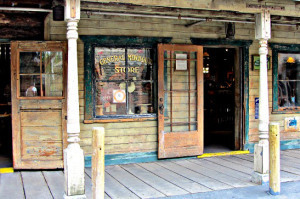 Nineteenth-century frontier towns out on the edge of civilization couldn’t support a wide array of specialized stores. In those days, a shopping trip like the ones my mother made meant a visit to the local mercantile.
Nineteenth-century frontier towns out on the edge of civilization couldn’t support a wide array of specialized stores. In those days, a shopping trip like the ones my mother made meant a visit to the local mercantile.
If you could travel back in time and stroll into one of those general stores, what would you be able to find?
Men were in the majority among the early settlers, and that was reflected in the merchandise available. A homesteader’s purchases might include:
a keg of nails for putting up a barn;
doors and windows to spruce up the house in preparation for his wife’s arrival from the East;
shirts, jeans, and overalls to replace the tattered clothing he’d worn out making all those repairs.
And let’s not forget the animals on the homestead. Their needs could be met as well, with everything from veterinary supplies to harnesses and horseshoes.
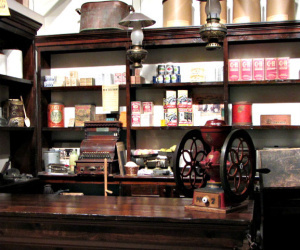
Arizona Historical Museum
Once the settler’s wife joined him, she might spend her shopping time exploring other areas of the store, stocking up on canned goods or laying in a supply of staples—flour, sugar, and the like. Arbuckles’ coffee was a popular brand of that day, and the beans could be ground right there in the store, just the way it happened at the Ross-Nelson Mercantile in Trouble in Store.
Next she could browse through bolts of fabric and assorted notions to choose the right combination for her next dress. Anything else she might need for herself or her household could be ordered through one of the available catalogs in the event the mercantile didn’t keep that item in stock.
 Another popular purchase was patent medicine. Advertisements for these remedies appeared in newspapers across the country, and a wide variety of them found a place on the shelves of many a frontier emporium.
Another popular purchase was patent medicine. Advertisements for these remedies appeared in newspapers across the country, and a wide variety of them found a place on the shelves of many a frontier emporium.
With so much to choose from, a shopper could spend a good bit of time browsing through all the items available. But the mercantile was more than just a place for shopping. It was a place where old-timers could gather to spin yarns . . . or play a game of checkers. A place to hear news and to share it, to mail a letter, to visit with far-flung neighbors.
It was part of the glue that helped hold a community together.
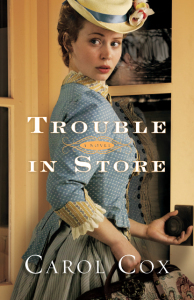
Another fun read from Carol Cox
Carol is giving away a copy of Trouble in Store. Comment on this post no later than 10pm (AZ time) Wednesday, July 3rd to be entered into the drawing. You must include your email address for notification.
MONA: Thank you, Carol, for this fabulous peek into the shopping adventures of our friends in the 1800s! We appreciate the Book Giveaway too!
CAROL: Thanks so much for inviting me to visit with you and your readers, Mona. It’s always a joy to spend time with you—especially when we can talk about days gone by!
Another great Old West, Arizona read from Carol Cox — Love in Disguise!








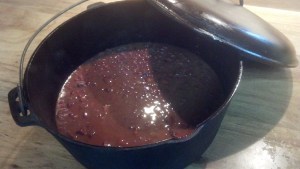

![ShowGlobeRed2[1]](https://i.gr-assets.com/images/S/compressed.photo.goodreads.com/hostedimages/1380940907i/3424924._SY540_.jpg)
![SodaSip[1]](https://i.gr-assets.com/images/S/compressed.photo.goodreads.com/hostedimages/1380940907i/3424926.jpg)




